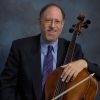
The Joy of Feuillard – A Sequential Approach to Teaching Bow Technique (Part 4 – Preliminaries: The Second Lesson)
Robert Jesselson
Part 4 – Preliminaries: The Second Lesson
Part 3 presented preliminary concepts which are necessary before starting the bowing exercises in Feuillard. These include the “core” sound, the “block of sound”, playing with a “straight” bow, and a basic kinesthetic understanding of how the bow arm works (the correct movement of the upper and lower arm, and the elbow). These are all issues which should be addressed in the very first lesson with a new student. I spend a lot of time working with the bow arm first, because if a student can’t get a good sound with the bow it won’t matter how beautifully the left hand works. Basic sound production comes before addressing the myriad number of left hand issues involved in playing the cello (intonation, vibrato, shifting, articulation, coordination, double stops, etc.).
Although we are focusing on the bow in this series of Blogs, that first lesson would also include some basic information about the left hand, including the shape of the fingers on the fingerboard, knowledge of how the position numbering system works, and how to check first position (first finger with the string above creating a perfect 4th, and the fourth finger with the string below creating an octave). I also explain the initial scale system that we will use – two octave scales (Feuillard #10) and two octave arpeggios (Feuillard #11). I have specific pedagogical goals with these left-hand issues in the first lesson, but that is outside the scope of this Blog. Perhaps when I am done with this series I will continue with another series of blogs on the left hand…
So, continuing with the preliminary information that should be presented in the first two lessons, we will explore the Three Principles of Tone Production, the placement and function of the fingers on the bow, and the “all important” concept of contrary or “Left/Right” Motion.
In Caroline’s second lesson I presented the Three Principles of Tone Production, which are:
- Contact Point – where the bow is placed on the string
- Weight – meaning how much arm weight we use on the bow
- Speed of Bow – how fast we move the bow
These Three Principles are the most important elements for producing sound and for changing the color and volume of the sound. Learning to control these Three Principles is one of the most basic tasks for a string player – and yet it is among the most important parts of the journey of artistic discovery for seasoned professionals as well. As cellists we are continually searching for new colors in our playing and for better control of the bow. And the search never ends…
In Caroline’s third lesson we reviewed the Three Principles that I presented in the second lesson, and then discussed some of the “rules” which can help in sorting out how the three Principles interact:
Three Principles of Tone Production:
The cellist must internalize these basic “rules” – we don’t exactly have to memorize them, but we do need to absorb them so that we can produce the sound we want and respond quickly if the sound that comes out is not what we want. Some of these important rules are:
The lower the string, the more weight we need to use.
The closer to the bridge, the more weight we need to use.
The lower the string, the slower the bow speed we need to use.
The faster the bow speed, the higher the contact point we need to use.
The higher the string, the lower the contact point we need to use.
The higher up you play on a string, the lower the contact point we need to use.
Most young cellists are not aware of the difference between passive arm weight and applying pressure on the bow. So I usually have to help them become sensitized to the feeling that the weight of the arm is enough to create a big sound. They must recognize that pressing the bow onto the string will be counter-productive. A few exercises can help them become aware of the importance of arm weight.
Arm Weight:
I usually address the actual bow “hold” only after the student has started working with all these other elements. I find that it is better for the student to absorb these preliminary concepts and recognize the immediate change in their sound and ease of playing. I find that it is psychologically helpful in gaining the confidence of new students when they find that their work is paying off right away. Making changes in their bow hold often produces less of an immediate impact, and sometimes is more difficult to change. So I prefer to delay that until the second lesson.
I don’t like to use the terms “bow hold” or “bow grip”, because “holding” the bow implies using muscles. I prefer to say “bow balance” – but I often end up saying “bow hold” anyway since I haven’t come up with a good, practical alternative term to use…
I divide the information about the bow hold into two parts: the “Placement of the Fingers on the Bow” and the “Function of the Fingers on the Bow”. I have found that even very advanced players are often not aware of the various “personalities” that the different fingers have on the bow. By focusing on the individual properties or “functions” of the different fingers we have specific mechanisms to change our sound, articulation, stokes, etc.
In the third lesson with Caroline I asked her to review the information about finger Placement and Function that I had told her in the previous lesson:
Finger Placement and Function:
So the Placement of the Fingers on the bow:
1st finger – on the grip
2nd finger – on the metal tab, with the pad of the finger slightly below the ferrule
3rd finger – on or near the eyelet, depending on the size of the hand
4th finger – the pad of the finger goes on the junction of the two woods (ebony and pernambuco)
Thumb – on the junction of the two woods opposite the 2nd finger, on a slight diagonal to the stick
And the Function of the Fingers on the bow:
1st finger – transfers the weight of the arm into the bow
2nd finger – serves as an anchor to keep the hand in place on the bow
3rd finger – helps determine the spacing of the fingers (we want approximately even spacing of the fingers. Being aware of the space between the 2nd and 3rd fingers helps determine the spacing of the other fingers; the 3rd finger is also responsible for the rotation of the bow that results in more or less hair on the string; it is also the “centering” finger, which can help with relaxation. The third finger is the most “elusive” of all the fingers, but having a good appreciation of its function helps to create a more sophisticated use of the bow.
4th finger – balance finger (very important for string crossings and off-the-string strokes). I often put the little finger on the top of the stick to help feel this balance function. We’ll discuss this further in another Blog.
Thumb – counter-balance to the other fingers; the “boss” or “guide” finger.
It is very important to make the student aware of thumb issues right from the beginning. The thumbs should be round and flexible. The thumb on the bow is one of the major contributors to excess tension if not set up and addressed properly. I have found that when I work with college students whose thumbs are incorrectly bent in, even if they play quite well it is very difficult for them to change this bad habit. And if they don’t change it they are very limited with what they can do in playing fast strokes, or playing accurately. If not corrected, the thumb can be a major underlying cause of tendonitis.
Thumb:
Next the student needs to explore how the little finger balances the bow and controls many of the movements of the bow:
Exercise for Little Finger:
Paul Katz tells a wonderful little story that conveys a lot of information about the fingers on the bow:
Paul Katz Story:
Now we are ready for one of the most important concepts for producing a good sound and making it easier to play with less physical effort: Left/Right motion (or “contrary” motion). I usually introduce this in the very first lesson, and then expand on it in subsequent lessons. I find that when a student begins to understand the concept of balance their playing improves significantly.
Left/Right Motion:
In next week’s Blog we will start our work on the Feuillard Daily Exercises, with the theme of No. 32, and the first few variations.
*If you have questions or comments about The Joy of Feuillard, Dr. Robert Jesselson can be reached directly at rjesselson@mozart.sc.edu.
Subjects: Repertoire, Technique
